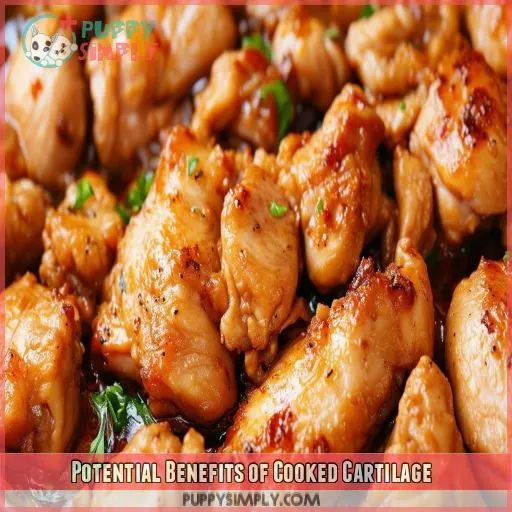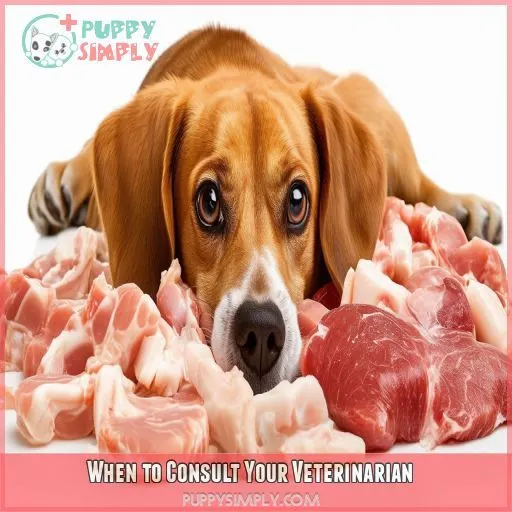This site is supported by our readers. We may earn a commission, at no cost to you, if you purchase through links.
 Imagine your dog looking at a turkey carcass after Thanksgiving. Can dogs eat cooked cartilage safely?
Imagine your dog looking at a turkey carcass after Thanksgiving. Can dogs eat cooked cartilage safely?
Though carte provisions are considered a healthy treatment with the benefit of joint support and dental care, they are not without the risks involved, like choking or digestive issues.
This article explores the pros and cons, safe preparation, and alternatives. From these factors, you can make an informed decision about your pet’s safety and well-being
Table Of Contents
- Key Takeaways
- Can Dogs Eat Cooked Cartilage?
- Understanding Cooked Cartilage for Dogs
- Potential Benefits of Cooked Cartilage
- Risks Associated With Feeding Cooked Cartilage
- Safe Preparation Methods for Cartilage
- Alternatives to Cooked Cartilage for Dogs
- When to Consult Your Veterinarian
- Frequently Asked Questions (FAQs)
- Is it safe to eat animal cartilage?
- Are cooked bones safe for dogs?
- Can dogs have pig cartilage?
- Can I give my dog a cooked pork bone?
- Can dogs eat pork cartilage?
- Can dogs eat fish cartilage?
- Can you eat cartilage?
- Can you eat chicken cartilage?
- Can cooked cartilage help with dental health?
- What is the nutritional value of cartilage?
- How often can dogs eat cooked cartilage?
- Are all types of cartilage safe for dogs?
- What are signs of cartilage-related digestive problems?
- Conclusion
Key Takeaways
- cooked cartilage can be a double-edged sword for dogs – it’s packed with joint-supporting nutrients but can also be a choking hazard. Talk about being stuck between a rock and a hard place!
- Moderation is key, folks. Treat cooked cartilage like that one relative who overstays their welcome – a little bit goes a long way. Once or twice a week as a treat should do the trick.
- Keep your eyes peeled for any funny business after Fido chows down on cartilage. If your pup starts acting like they’ve got a bone to pick with their stomach, it’s time to ring up the vet.
- When in doubt, play it safe and explore alternatives. There’s a whole world of dog-friendly chews out there that’ll make your furry friend’s tail wag without giving you gray hairs. After all, a happy dog means a happy human!
Can Dogs Eat Cooked Cartilage?
Yes, dogs can eat cooked cartilage, but some precautions must be taken. Added nutrition, essential minerals, and collagen—a substance suitable for joints and dental hygiene—will be received from the cooked cartilage.
However, there are specific associated risks to be wary of: choking hazards and digestive issues.
To feed cooked cartilage safely: boil or steam it to reduce bacteria, dice into small pieces, and monitor portion sizes. Always be with your puppy when they are eating this treat. If you notice any discomfort or unusual behavior, consult the vet.
Although cooked cartilage may form a healthy addition to your dog’s diet, there is still more to consider before making it a regular treat
Understanding Cooked Cartilage for Dogs
Cooked cartilage can be a bit of a complex treat for your dog. Generally, it’s full of nutrients, not unlike bone marrow, and can work as a dietary supplement.
However, one needs to be very mindful of the form cartilage takes and how it has been prepared. Cooked cartilage may break down or splinter into bone fragments, which present apparent choking hazards, not to mention digestive hazards. Make sure that cartilage is soft, both for dental health and to prevent bone disease, accompanied by supervision at ingestion.
Alternatively, look for cartilage alternatives that can be safe for bone health and security for your pet
Potential Benefits of Cooked Cartilage
Cooked cartilage offers nutritional benefits, including essential minerals and collagen, which support your dog’s joint health. Additionally, chewing on cooked cartilage can provide dental benefits by helping to clean teeth and gums
Nutritional Value
Cooked cartilage is full of nutrients that help serve as dietary supplements for dogs. Added to the list are proteins, collagen, and minerals such as calcium and phosphorus, essential dog nutrition elements.
So, incorporating cooked cartilage in making homemade dog sweet treats will ensure a boost in dog nutrition.
Of course, knowing the nutritional makeup allows one to keep the bones and cartilage of your pet in perfect balance for long-term benefits
Joint Health Support
Cooked cartilage can support joint health in dogs due to its collagen content, which aids in maintaining joint elasticity and reducing inflammation. It may help your furry friend stay active and pain-free by:
- Promoting cartilage repair
- Enhancing bone health
- Supporting joint flexibility
- Reducing arthritis symptoms
However, always prioritize safety to avoid any digestive problems
Dental Benefits
Cooked cartilage can also provide dental benefits for your pup. The crunchy texture helps scrape away plaque and tartar, promoting gum health and freshening breath. Plus, the calcium and other minerals in cartilage can strengthen tooth enamel. Just be sure to monitor for any mouth injuries or digestive issues
Risks Associated With Feeding Cooked Cartilage
Feeding your dog cooked cartilage poses several risks, including choking hazards and digestive issues. There’s also the potential for obstruction, which can lead to serious health problems
Choking Hazards
While cooked cartilage offers some benefits for your dog’s joint health and teeth, it also presents choking risks. Dogs can experience severe difficulties if cartilage gets lodged in their throat. To prevent this:
- Avoid feeding small, brittle pieces.
- Supervise your dog while eating.
- Opt for safer alternatives like dog chews or raw bones
Digestive Issues
While cooked cartilage may be tempting, it can pose digestive challenges for dogs. Cartilage may be difficult to break down, potentially leading to constipation, vomiting, or other gastrointestinal distress. Monitor your pup closely after feeding cartilage and consult your vet if you notice any signs of discomfort or blockage
Potential for Obstruction
Feeding dogs cooked cartilage can obstruct with pieces too large for the breed. It is, therefore, essential to choose the right-sized treat and consider alternative safer options in raw cartilage and commercially safe chews. Monitor your dog at every instance and consult with a vet if it’s showing distress signs.
Safe Preparation Methods for Cartilage
To safely prepare dog cartilage, start by boiling or steaming it well to minimize bacterial contamination.
Don’t add seasonings, as they’ll be detrimental.
Dice the cartilage into small, manageable-size pieces.
Monitor portion sizes very closely; it should only be a minor supplement to their diets to ensure balanced nutrition is maintained.
Cooking alone should retain the nutritional value while making it safe for consumption.
Follow these safe feeding tips to ensure bone growth and health
Alternatives to Cooked Cartilage for Dogs
For safer options than cooked cartilage, consider commercial chews, raw cartilage, or non-animal alternatives. These options can provide similar benefits without the risks of choking or digestive issues
Commercial Chews
Commercial chews, a safe alternative to cooked cartilage, are designed with additives and suitable compositions to enhance bone density and development. They come in a variety of options, ensuring sourcing quality. Choose products free of harmful additives to support your dog’s bone health and mitigate risks like bone cancer. Always supervise chewing sessions for safety
Raw Cartilage Options
For the raw cartilage options, ensure that you choose portions with the correct size considering your dog’s breed. This would be in the form of rib or ham cartilage. Always supervise during chewing to avoid choking and verify storage conditions for maintaining nutritional content.
Toy-like alternatives would almost reduce the risks. Much like entering a bone marrow registry, care and precision will be essential to health
Non-Animal Alternatives
If your dog has dietary restrictions or you simply prefer non-animal options, there are vegetarian cartilage supplements available. These plant-based alternatives can provide similar joint support without the risks associated with cooked cartilage. Speak with your vet to find the right supplement for your pup’s needs
When to Consult Your Veterinarian
Knowing when to consult your veterinarian when feeding your dog cooked cartilage. Here’s what to watch for:
- Choking: Coughing immediately or frequently.
- Gastrointestinal problems: Vomiting, diarrhea, or a distended abdomen.
- Obstruction: Difficulty passing stools or blood in the stool.
- Shortness of breath: Wheezing, labored breathing.
- Bizarre behavior: Excessive drooling, fidgety, or lethargic.
The presence of the following signs can present serious problems and may indicate that your dog needs professional attention for his safety and health.
Frequently Asked Questions (FAQs)
Is it safe to eat animal cartilage?
Generally, animal cartilage is relatively safe to eat. It contains much collagen and may help with joint health. Ensure it has been well-cooked since raw cartilage may come loaded with bacteria. Always consult a doctor for advice about your diet.
Are cooked bones safe for dogs?
Cooked bones can be a dog’s worst nightmare! They’re not safe for your furry friend. When cooked, bones become brittle and can splinter, potentially causing choking or internal injuries. It’s best to avoid them entirely
Can dogs have pig cartilage?
You can offer your dog pig cartilage, but it’s best served raw. It’s a chewy treat that’s rich in glucosamine and chondroitin, supporting joint health. Always supervise and choose appropriate sizes to prevent choking hazards
Can I give my dog a cooked pork bone?
Imagine a knight’s armor: protective yet dangerous. You shouldn’t give your dog cooked pork bones. They can splinter, causing internal injuries. Instead, opt for safe alternatives like specially designed chew toys or raw bones recommended by your vet
Can dogs eat pork cartilage?
You can feed your dog pork cartilage, but it’s best to do so in moderation. It’s a good source of glucosamine and chondroitin, which support joint health. Always supervise and choose appropriate sizes to prevent choking hazards
Can dogs eat fish cartilage?
Like a treasure trove of nutrients, fish cartilage can be a healthy treat for your dog. It’s rich in glucosamine and chondroitin, supporting joint health. Offer it in moderation, ensuring it’s thoroughly cooked to prevent choking hazards
Can you eat cartilage?
You can eat cartilage, though it’s not commonly consumed. It’s tough and chewy but contains beneficial nutrients like collagen. You’ll find it in dishes like chicken feet or fish heads. It’s safe but may not appeal to everyone
Can you eat chicken cartilage?
Chicken cartilage is edible, and it crunches satisfactorily while being loaded with nutrients such as collagen and glucosamine. It might also help the joints. Some consider its texture off-putting, while others find it appealing. Always cook it well before consuming.
Can cooked cartilage help with dental health?
Did you know that 80% of dogs over three have dental issues? While cooked cartilage isn’t as effective as raw bones, it can still offer some dental benefits. It’s chewy texture may help remove plaque, but it’s not a substitute for proper dental care
What is the nutritional value of cartilage?
Cartilage packs a nutritional punch with glucosamine, chondroitin, and collagen. These compounds support joint health and mobility. You’ll also find minerals like calcium and phosphorus, which are essential for strong bones and teeth
How often can dogs eat cooked cartilage?
You shouldn’t feed your dog cooked cartilage regularly. It’s best to limit it to once or twice a week as an occasional treat. Always monitor your pup for any digestive issues and consult your vet for personalized advice
Are all types of cartilage safe for dogs?
Not all cartilage is created equal. While soft, flexible types can be safe, hard or weight-bearing cartilage poses risks. You’ll want to avoid feeding your dog cartilage from ribs, joints, or trachea to prevent potential choking hazards
What are signs of cartilage-related digestive problems?
Watch for vomiting, diarrhea, lethargy, or loss of appetite in your dog. Abdominal pain, bloating, or straining to defecate can also indicate issues. If you notice these signs, it’s best to contact your vet promptly for guidance
Conclusion
Ultimately, "Can dogs eat cooked cartilage?" isn’t a black or white issue. It’s laden with benefits for joint health and dental care but carries risks of choking and gastrointestinal problems.
It’s incumbent upon an owner to strike a balance between these considerations, not emphasizing one over the other. In this regard, consult with your vet for advice. Remember, your mileage may vary when it comes to individual dogs.
If you decide to feed your pet cooked cartilage, ensure proper cooking and supervision. Always make sure your furry friend is safe and comfortable with the dietary decision you’re making












